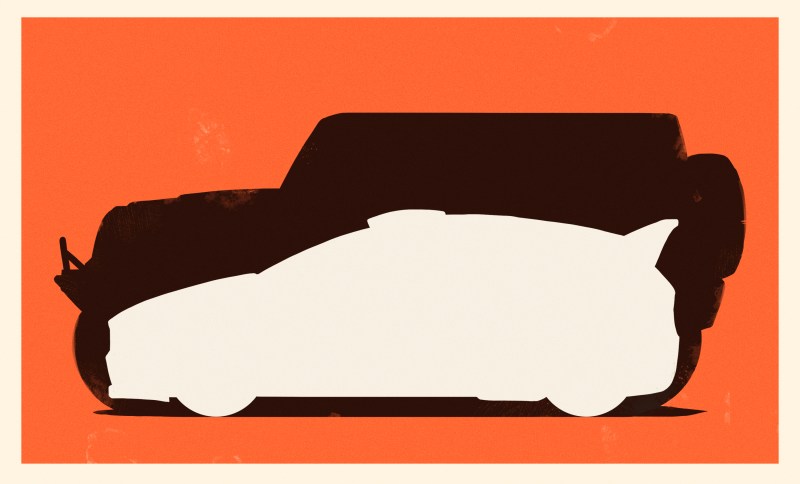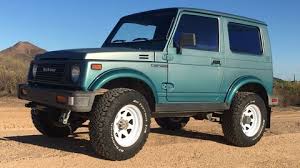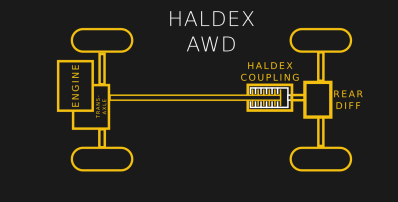The Difference Between 4WD and AWD

Car manufacturers will often tout a vehicle’s features to appeal to the market, and this often leads to advertisements featuring a cacophony of acronyms and buzzwords to dazzle and confuse the prospective buyer. This can be particularly obvious when looking at drivelines. The terms four-wheel drive, all-wheel drive, and full-time and part-time are bandied about, but what do they actually mean? Are they all the same, meaning all wheels are driven or is there more to it? Let’s dive into the technology and find out.
Part-Time 4WD

Part-time four-wheel drive is the simplest system, most commonly found on older off-road vehicles like Jeeps, Land Cruisers and Land Rovers up to the early 1990s, as well as pickup trucks and other heavy duty applications. In these vehicles, the engine sends its power to a transfer case, which sends an equal amount of torque to the front and rear differentials, and essentially ties their input shafts together. This is good for slippery off-road situations, as some torque is provided to both axles at all times. However, this system has the drawback that it can’t be driven in four-wheel drive mode at all times. With the front and rear differentials rotating together, any difference in rotational speed between the front and rear wheels — such as from turning a corner or uneven tyre wear — would cause a problem. The drive shaft going to one differential would want to turn further than the other, a problem known as wind-up.

Wind-up causes transfer case components to snap or break. Thus, these systems should only be driven in four-wheel drive mode on loose surfaces, where tyres can slip a little to avoid wind-up in the drive train. Hence, they are called part-time four wheel drive systems, as the transfer case can be shifted to 2WD mode, sending power to just one axle for driving on sealed roads. This avoids the wind-up problem, but means that these systems only really add traction when engaged off-road on dirt, sand, or snow.
These systems also often incorporate a “low-range” gear in the transfer case, which gears down the drive ratio to the wheels, allowing much greater torque to be generated at the tyre and the vehicle to be driven more slowly. This is of major benefit in low-traction situations and when trying to slowly negotiate complex trails full of obstacles and ruts.
All-Wheel Drive, or Full-Time 4WD
 Obviously, in some situations, it’s desired to drive all four wheels of the vehicle even on high-traction, sealed surfaces. Thus, a solution to get around the problem of driveline wind-up is to install a third differential in a vehicle, in between the front and rear axles, in place of the transfer case. This center differential can allow for rotational speed differences between the front and rear axles, thus making it possible to drive all four wheels even on paved roads.
Obviously, in some situations, it’s desired to drive all four wheels of the vehicle even on high-traction, sealed surfaces. Thus, a solution to get around the problem of driveline wind-up is to install a third differential in a vehicle, in between the front and rear axles, in place of the transfer case. This center differential can allow for rotational speed differences between the front and rear axles, thus making it possible to drive all four wheels even on paved roads.

However, this comes with the drawback that the system can only deliver as much torque to one axle as is given to the other, due to the way differentials work. Thus, for example, if the front wheels are slipping, the rear axle will only receive as much torque as the front, and thus the vehicle will not be able to gain traction.
A variety of solutions are used to get around this problem. Off-road vehicles such as modern Land Cruisers and Range Rovers will have a switchable lock in the center differential, allowing equal torque to be sent to both ends when necessary. Alternatively, any one of a variety of limited-slip differentials can be installed in the center differential location, allowing a variable torque split depending on conditions. These systems are less capable offroad, but are less fuss for typical driving conditions. They are most commonly installed in cars intended for use on-road, but in occasional slippery conditions such as snow and ice. They’re also used in performance cars that drive all four wheels to put down power as effectively as possible for faster acceleration and better grip.
Front-Wheel Drive Based Systems

The other type of popular all-wheel drive system are the front-wheel drive based systems, most notably the Haldex type used in many smaller cars. These are installed most commonly in performance hatchbacks from brands like Volkswagen, Audi, and Mercedes. The systems work by having a typical front-wheel drive engine and transmission layout, with an extra drive shaft that goes to a special coupling which is then connected to the rear differential. Under normal conditions, the coupling, containing clutch packs, stays open, sending no torque to the rear wheels. However, under conditions where the front wheels start to slip and spin faster than the rears, the clutch pack is progressively engaged, sending up to 50% of torque to the rear wheels. The clutch pack is designed to operate at various levels of slip, allowing a variable amount of torque to be sent to the rear, usually anywhere from 100:0 front to back to a full 50:50 split. The Haldex system is often mocked and referred to as “faux-wheel drive”, as it only engages under such conditions. However, it is possible to engage the system manually using hacked controllers.

These systems are also used in rear-wheel drive based applications — such as the Bugatti Veyron and Lamborghini Aventador. The concept is the same, but as these vehicles are mid-engined, the coupling is instead installed on the front axle, with the rear axle getting the majority of the torque under most conditions.
Conclusion
Automotive marketing will always rely on buzzwords because it’s simply not practical to explain the mechanical specifics of a given vehicle’s driveline in a 30-second ad. However, armed with this knowledge, you should now be confident to shop for a vehicle that meets your needs based on what it’s got under the frame, not just on whatever fancy words are emblazoned on the badging. Be particularly wary of manufacturers that twist widely-accepted naming conventions to trick unknowing customers, and look at the components installed on the vehicle rather than the marketing terms to get a full understanding of how a given car will perform. Once you know what you’re looking for, you’ll be all the more ready to make the right decision!
Post a Comment